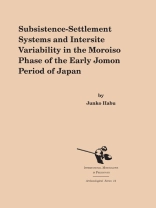This book examines the settlement patterns and intersite variability in lithic assemblages of Early Jomon (ca. 5000 BP) hunter-gatherers in Japan. A model is proposed that links regional settlement patterns and intersite lithic assemblage variability to residential mobility. The results of this study suggest that the Early Jomon people were not sedentary, as previously assumed, but instead moved their residential basis seasonally. The implications of this result are discussed in the context of the development of hunter-gatherer cultural complexity in general and the course of Japanese prehistory in particular.
Table of Content
List of Figures
List of Tables
Abstract
Acknowledgments
Chapter 1. Introduction
Chapter 2. Theoretical Approach
Chapter 3. Background to the Study: The Jomon Period
Chapter 4. Problems, Hypotheses, Materials and Methods
Chapter 5. Subsistence-Settlement Systems of the Moroiso Phase
Chapter 6. Changes in Subsistence-Settlement Systems Through the Moroiso Phase
Chapter 7. Discussion and Conclusions
Tables
References
About the author
Junko Habu is Associate Professor at the Department of Anthropology, University of California at Berkeley. She most recently co-edited Handbook of East and Southeast Asian Archaeology (Springer, 2017).












